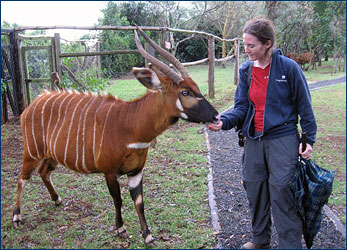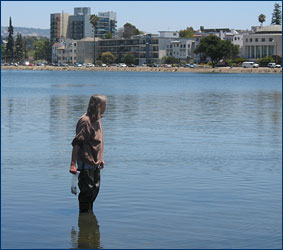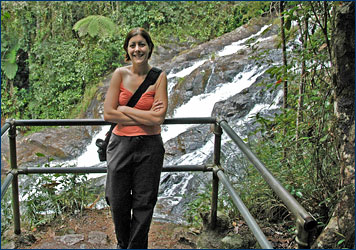

UCMP's summer adventures 2007
UCMP's summer adventures 2007 In keeping with tradition, this summer found some UCMP faculty, staff, and grad students working on projects at the museum, but many others continued their research and writing in places far afield. Here is a glimpse into some of their summer adventures.
In July, Tony Barnosky left for a year's sabbatical in Santiago, Chile, where he is writing a book on what fossils have to say about ecological effects of global warming. Tony is on a Fulbright Fellowship at Pontificia Universidad Catolica de Chile, where he is also initiating work on extinction of the South American megafauna.
Though Katie Brakora spent most of the summer teaching, her adventures took place a bit earlier. From January to June, Katie visited several institutions and explored various locations in Africa looking for antelopes and their skulls. She visited the National Museum Bloemfontein in South Africa for three weeks, followed by a drive to Etosha National Park (Namibia) with Wendy Turner from the Getz Lab. She spent two weeks looking for baby antelope and measuring springbok skulls at the Etosha Ecological Institute. Next up: two months in Nairobi at the National Museums of Kenya and visits to several national parks to photograph various species of spiral-horned antelope. Katie took two weeks off to visit fellow UCMP grad student Lorraine Casazza in Egypt and appreciated the large fossil foraminifera composing much of the architecture there. She finished up with a month of measuring skulls at the Transvaal Museum (South Africa), in time to change hemispheres and return home near the summer/winter equinox and begin teaching summer school a week later.
 |
 |
|
| Left: Katie Brakora feeds a docile pregnant bongo at the Mount Kenya Animal Orphanage. Right: Dawn Peterson samples the microfauna in Lake Merritt. | ||
Ken Finger and Dawn Peterson continued their dirty work looking at the distribution of living microfauna in Oakland's Lake Merritt. Thanks to a generous gift from alumnus Bruce Lander, their work this year was enhanced by the addition of a newly acquired YSI 85 field instrument that records temperature, salinity, conductivity, and dissolved oxygen (DO). As suspected, DO appears to be the primary factor in the distribution of living foraminifers and ostracodes, which were found to be restricted along the shallow edges of the lagoon, but absent from the interior substrate. This research project is revealing patterns that relate to local variations in freshwater influx, tidal currents, vertical mixing, and primary productivity. The ultimate goal of the study is to detect microfaunal changes resulting from pending improvements to the Lake Merritt environment. In turn, the findings will reveal the utility of these tiny "bugs and critters" in monitoring the health of coastal environments in urban areas.
Mark Goodwin spent two weeks working in Montana with Jack Horner and Museum of the Rockies graduate students. The first stop was along the Canadian border in the Judith River Formation at the Redding Field Station north of Rudyard, Montana, where Dan and Lila Redding and their family have graciously hosted many UCMP paleontologists and students. A dinosaur bonebed, discovered previously by UCMP, was reopened and yielded abundant cranial and skeletal hadrosaur bones. Mark headed east to the Upper Cretaceous Hell Creek and Paleocene Tullock Formations in Garfield County, Montana. Here, working with MOR graduate students John Scanella and Denver Fowler, previous UCMP Triceratops localities were revisited and stratigraphic sections and GPS coordinates were recorded. These exposures yielded a variety of dinosaur bones, including additional Triceratops skulls, an articulated Thescelosaurus foot, turtles, and crocodiles. Mark had an opportunity to check out the first confirmed Triceratops bonebed in the Hell Creek Formation, an important site and datum for his study proposing an historical and facies-related collecting bias of adult Triceratops. Mark and Jack will report on their findings this September at a weekend Ceratopsian Symposium, hosted by the Royal Tyrrell Museum, Drumheller, Alberta. Before leaving, Mark and Jack spent a few days on collaborative research in the collections of the Museum of the Rockies.
Returning from a semester-long sabbatical, Carole Hickman traveled to Hawaii to continue comparative studies of primitive microgastropods. She was joined by three colleagues in a successful search for a minute snail that feeds exclusively on the leaves of an endemic Hawaiian seagrass, leaving distinctive grazing traces. Documentation of two novel "mystery organs" in another microgastropod will "force" her to return to Hawaii in October for additional electron microscopy. She also presented a paper at the World Congress of Malacology in Antwerp in a symposium highlighting new methods for collecting, preparing, and analyzing living and fossil micromollusks.
Pat Holroyd, accompanied by retired UCMP research paleontologist Howard Hutchison, returned to the early Eocene of the Bighorn and Green River Basins of Wyoming. UCMP has a unique collection of fossil reptiles through the two major episodes of global warming that have occurred in the last 60 million years. These collections are currently the only high-resolution records that allow us to assess how reptile faunas respond as temperatures increase. This summer, Pat and Howard worked to fill in stratigraphic gaps in these collections and add to our understanding of the faunal response. Pat notes that this year they felt a particular affinity with their study animals, as temperatures topped 100 degrees Fahrenheit in the field nearly every day. While the focus of study was to find fossils in areas where fossils are rare (when even the humblest piece of turtle shell makes a fine data point), they were also rewarded with many partial and articulated skeletons, a highlight of which was the discovery of a skull and associated shell of a new, undescribed genus and species of pond turtle.
Randy Irmis spent mid-May through late June in the field at Ghost Ranch. This project, which is continued from last year, focuses on excavating the Hayden Quarry — a new, early dinosaur site. This effort is in collaboration with former UCMP undergrad Sterling Nesbitt and Alan Turner at the American Museum of Natural History, Nate Smith at the Field Museum of Natural History, and Alex Downs at Ghost Ranch. Sarah Werning also joined the field crew this year. This was another successful field season, excavating over 1,000 specimens. They also focused on screenwashing for microvertebrates; bringing back several hundred pounds of screenwash sediment for picking at UCMP. Also during this time, a paper with Kevin Padian and colleagues listed above came out in Science, describing some of the finds from the Hayden Quarry last year. "We were lucky enough to be featured on the cover with some great artwork by Donna Braginetz (at right)." You can read a series of dispatches sent from Randy during his field work at the Hayden Quarry on the UCMP website. See Investigating the rise of dinosaurs: Field notes from Randy Irmis.
Randy spent July at Petrified Forest National Park in Arizona working with Bill Parker on several research projects. They finished up two manuscripts describing new aetosaur material from the park and Texas, and worked with Sterling Nesbitt on writing up the full description of the unusual archosaur, Revueltosaurus.
 Jenny McGuire at Dinner Falls, Mt. Hypipamee National Park, Queensland, Australia. |
Jenny McGuire had an exceptionally busy summer attending two conferences and a summer short course, preparing samples for radiocarbon dating, and working on integrating the MIOMAP and FAUNMAP databases. The American Society of Mammalogy was held in Albuquerque this June, and Jenny presented work on distinguishing between ambiguous vole species using molar shape. Following that conference, she helped organize and attended the Geometric Morphometrics Summer Short course here at Berkeley. "The course really helped progress my ideas about my research, looking at tooth shape in Microtus across space and through time." Then in July, thanks to a Young Scientists Fellowship through the National Academy of Sciences, Jenny attended the International Union for Quaternary Research (INQUA) Congress in Cairns, Queensland, Australia. "There I presented the work of myself, Tony Barnosky and Marc Carrasco about using species-area curves and morphoclimate models in forecasting effects of climate change on vertebrate communities." Returning from INQUA, Jenny spent a week at Lawrence Livermore National Laboratory radiocarbon dating bones from the Pacheco fossil locality and charcoal from Samwel Cave. When she was not traveling, Jenny worked on a project to update the MIOMAP webpage so that both the MIOMAP and FAUNMAP databases can be searched simultaneously. The FAUNMAP database contains a record of fossil localities from the late Quaternary, while MIOMAP includes localities from the Oligocene to the Pliocene. "With this integrated search function, we can search tens of thousands of localities at the press of a button, tracing how mammalian ranges have changed over the last 30 million years."
Erin Meyer spent her first field season as a graduate student on the gorgeous coast of Bermuda. The trip was made possible by grants from the Berkeley Chapter of Sigma Xi, the Houston Conchology Society and the Bermuda Zoological Society, along with field support from Dr. Kathryn Coates and Dr. Jeremy Madeiros of the Bermuda Department of Conservation Services, and field assistance from Michael Beetham.
Erin collected samples for a population genetics investigation of the West Indian Topshell (Cittarium pica) and conducted population surveys, recording habitat and morphological characteristics. This intriguing marine gastropod exists throughout the Neo-Tropical Western Atlantic, extending from Bermuda south to Venezuela and is one of the two large (>100 mm) gastropods in this region that is valued as a food source It lives in the rocky intertidal, where the large waves and surge common along the southern coast of Bermuda crash against the sharp, Pleistocene outcroppings. Because of this, collecting these critters required a delicate balancing act of walking on slippery, algae-covered rocks while being slammed relentlessly by waves and desperately trying to remove C. pica from rocks to which they're strongly attached by their foot. On this trip, Erin successfully tagged and collected tissue samples from 113 individuals from five different sites, conducted two population surveys, and claims, "I have the scars to prove it." The tissue samples will be used in an intensive population genetics investigation of this species throughout its range to determine the genetic viability of the Bermuda population, and will be combined with the population surveys to evaluate the reintroduction of the species to Bermuda. C. pica was reintroduced to Bermuda in 1982 after going locally extinct sometime between the Pleistocene and the mid-1800s. It is currently listed as a fully protected species under the Fisheries (Protected Species) Order of 1989.
Nick Pyenson spent a summer on the South Island of New Zealand, working with Ewan Fordyce in the Geology Department and Geology Museum at the University of Otago, in Dunedin. Nick worked on the Geology Museum's large collection of late Oligocene mysticetes, focusing on the world's largest sample of early baleen-bearing mysticetes called eomysticetids. These mysticetes provide important clues into a fundamental transition in baleen whale evolution from toothed mysticetes to toothless and baleen-bearing mysticetes. By using a database of measurements from living mysticetes that he collected with his colleague, Jeremy Goldbogen, at the University of British Columbia, Nick hopes to better characterize the morphology of eomysticetids in the context of living baleen whales: "These early baleen whales have a skull shaped like a long and pointed arrowhead — much more narrow than any other known baleen whale, living or extinct. That shape, together with the morphology of their jaws informs us about how their feeding strategy was much different from living baleen whales."
While there, Nick also assisted Ewan with molding, casting, and assembling an exhibit on Oligocene cetaceans for the Fukui Prefectural Museum in Japan, and found time to visit the Canterbury Museum in Christchurch and the Museum of New Zealand Te Papa Tongarewa in Wellington. Although June and August means winter weather in New Zealand, Nick made sure to explore as much of the outdoors as possible: "I spent time watching penguins and fur seals on the beach, hiking in southern beech forests of the Southern Alps listening for alpine parrots, and I prospected for fossils with Ewan in the Otago and Canterbury hinterlands. The scenery and geology were just fantastic." Nick says that he gained a new appreciation for meat pies, savory scones, and tea time, and can happily report that there are heaps of fine Kiwi beers as well.
Jann Vendetti traveled to Antwerp, Belgium in July to attend the Unitas Malacologica World Congress of Malacology meeting and present a paper on some work on gastropod protoconch morphology. She then took a train trip through Germany on to Copenhagen, Denmark to look at the fantastic Thorson egg capsule collection at the Zoological Museum of the University of Copenhagen.
Katie Brakora with bongo courtesy of Katie Brakora; Dawn Peterson by Ken Finger; Mark Goodwin and Triceratops bonebed courtesy of Mark Goodwin; Howard Hutchison by Pat Holroyd; Science cover courtesy of Kevin Padian; Jenny McGuire courtesy of Jenny McGuire; Erin Meyer and Cittarium pica courtesy of Erin Meyer; gastropod egg capsules by Jann Vendetti (all previous photos © UCMP). Nick Pyenson by R.E. Fordyce.